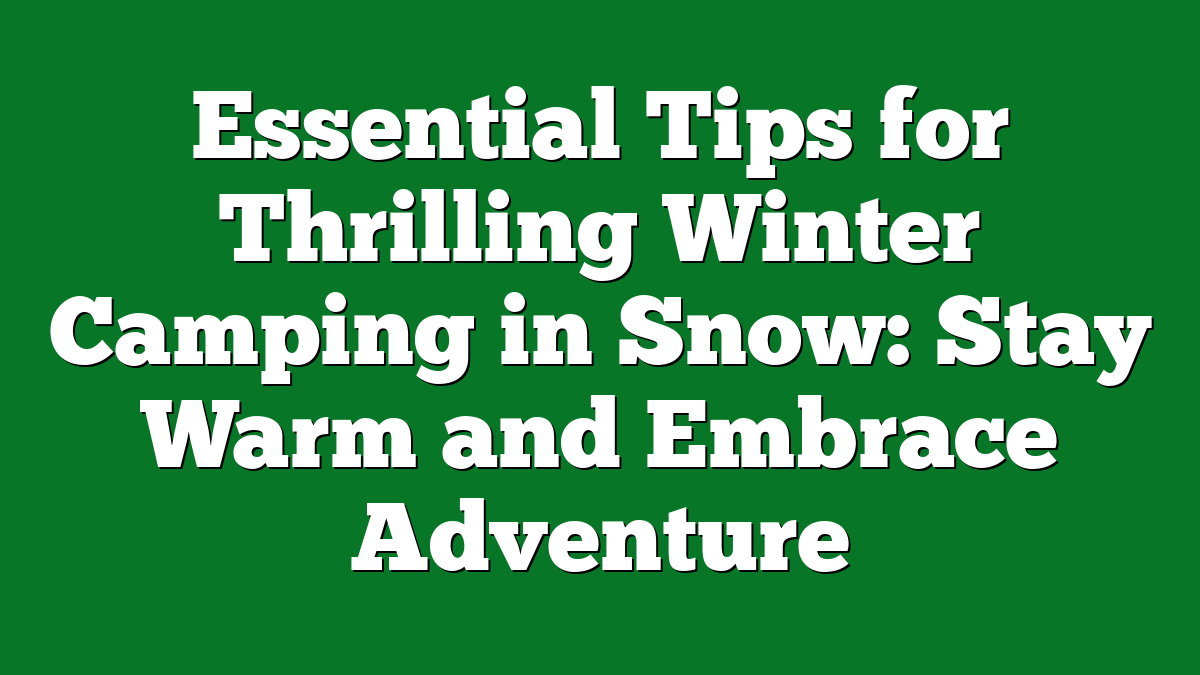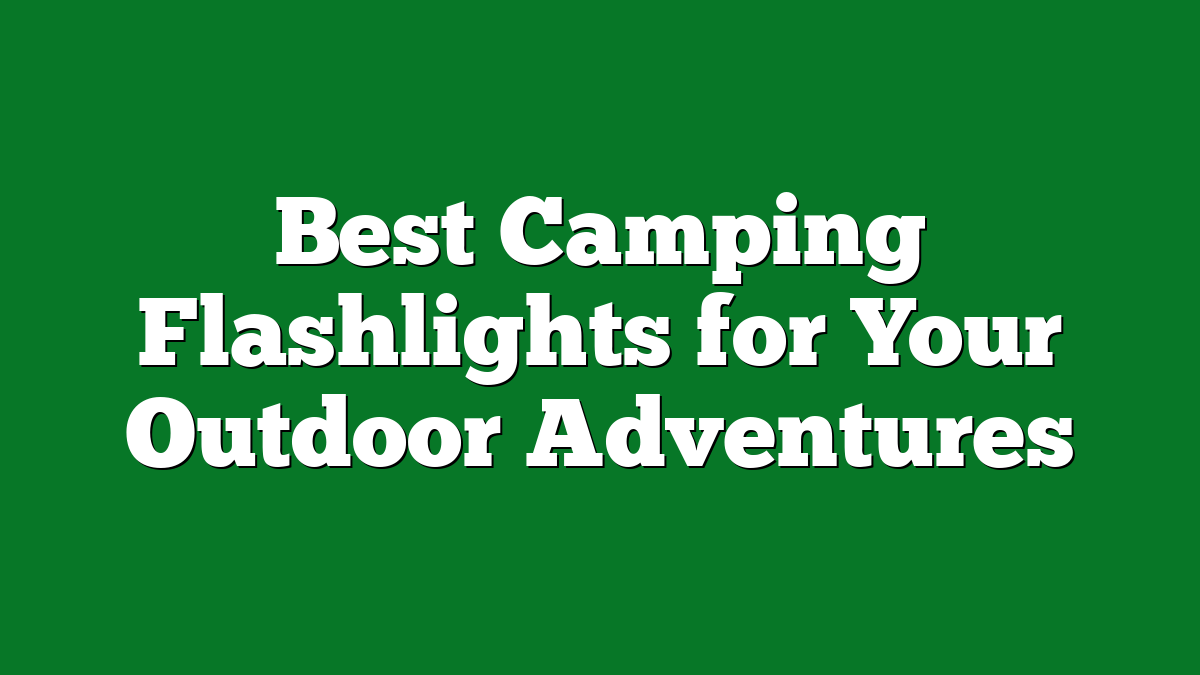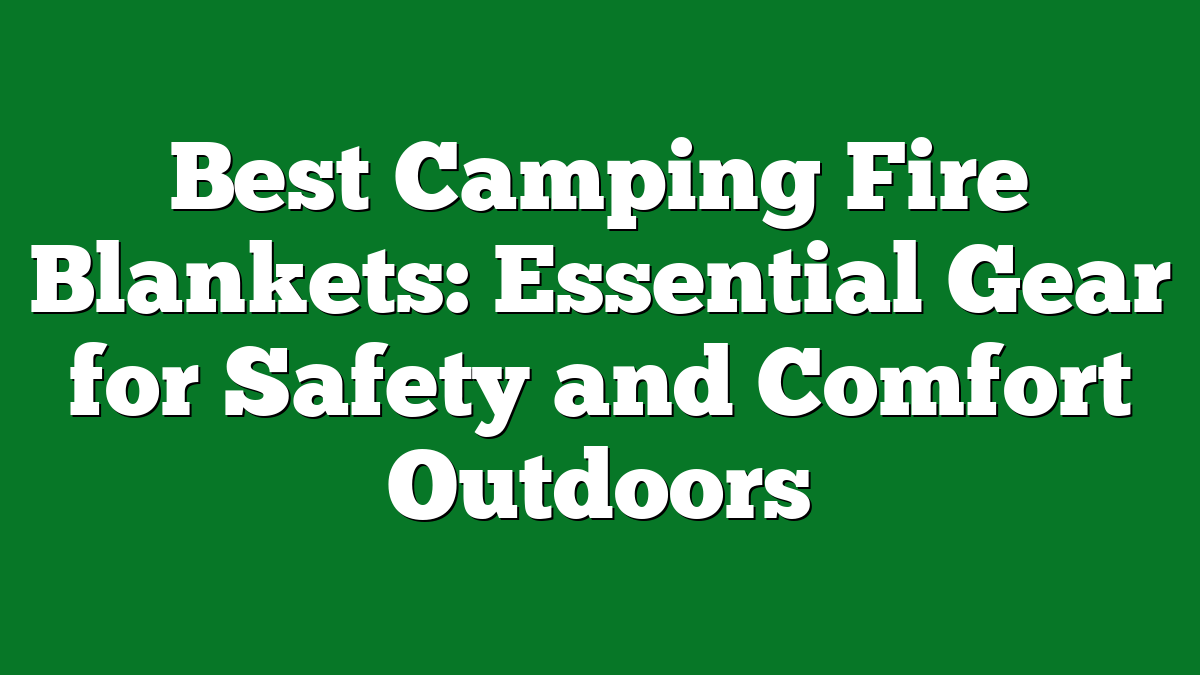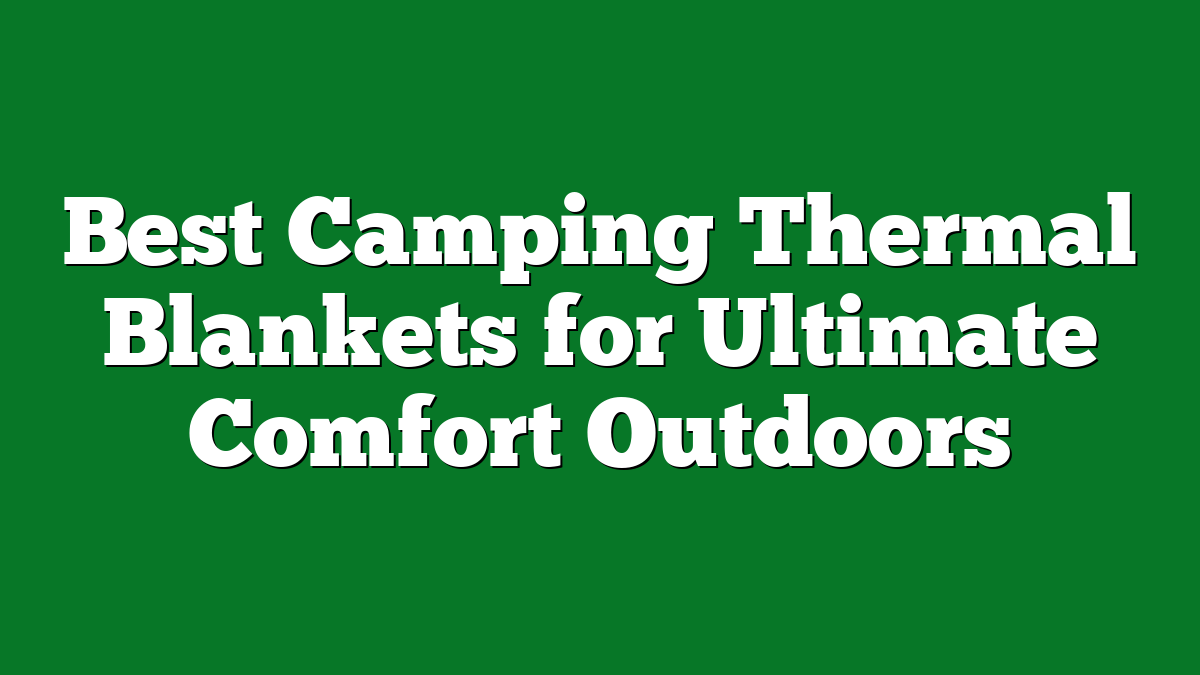Winter camping in the snow can feel like a thrilling adventure, but it also comes with its own set of challenges. I’ve spent countless nights under a blanket of stars with a fresh layer of snow crunching beneath my boots, and I can tell you—it’s an experience like no other. The crisp air and serene landscapes create a magical backdrop, but staying warm and safe is key to enjoying it.
Best Tips for Winter Camping in Snow
Winter camping in the snow brings unique joys and challenges. I find that planning is essential to enjoy the experience.
- Choose the Right Gear: Select a four-season tent for stability against snow and wind. Use sleeping bags rated for sub-zero temperatures to stay warm. Insulated pads prevent heat loss to the ground.
- Dress in Layers: Base layers made from moisture-wicking materials keep you dry. Mid-layers, like fleece, provide insulation. An outer shell shield from wind and moisture.
- Stay Hydrated: While it may seem less necessary in cold weather, staying hydrated fuels your body and helps regulate temperature. Melt snow for water, but ensure it’s purified before drinking.
- Prepare Meals Wisely: Use a stove that handles cold temperatures effectively. Carry foods that are high in calories but easy to prepare, like instant oatmeal or energy bars.
- Set Up Camp Properly: Look for flat ground to pitch your tent, avoiding areas prone to avalanches. Create windbreaks using snow structures for added protection.
- Maintain a Fire Safely: If allowed, gather dry wood and build your fire within a safe area. An adequate fire provides warmth and a morale boost.
- Be Mindful of Snow Conditions: Monitor for signs of avalanches and unstable snow layers. Recognizing these dangers makes for a safer camping experience.
- Embrace the Light: Daylight hours are short in winter. Plan activities to maximize sunlight, enhancing enjoyment and safety.
- Keep Electronics Charged: Cold drains battery life. Store devices close to your body and use battery-operated chargers to maintain power for emergencies.
- Know How to Handle Emergencies: Familiarize yourself with first-aid basics for hypothermia and frostbite. Carry a fully stocked survival kit for unexpected situations.
Preparing for Winter Camping
Preparing for winter camping in snow takes careful planning and the right mindset to ensure a safe and enjoyable adventure. I focus on selecting essential gear and understanding weather conditions to tackle the challenges of the cold.
Choosing the Right Gear
Choosing the right gear is crucial for a successful winter camping experience. I always rely on a four-season tent, which stands strong against heavy snow and strong winds. A sub-zero rated sleeping bag keeps me warm when temperatures drop significantly, and an insulated sleeping pad provides added protection from the cold ground.
I dress in layers, starting with moisture-wicking base layers, followed by insulating mid-layers, and topping it off with a waterproof and windproof outer shell. For my feet, I choose thermal socks and waterproof boots, ensuring warmth and dryness. In addition, I carry a quality stove that operates efficiently in cold conditions and high-calorie food items like trail mix, energy bars, and freeze-dried meals to keep my energy levels up.
Weather Considerations
Weather considerations play a major role in winter camping. I check forecasts regularly for temperature, wind speed, and potential snowfall. Understanding these factors helps me make informed decisions about my trip. It’s wise to avoid camping during severe weather warnings or rising avalanche risks.
I keep an eye on changing weather conditions while camping. If clouds roll in or temperatures drop unexpectedly, I adjust my plans to stay safe. I make sure to maximize daylight hours for activities and set up camp before dark, ensuring I have adequate time to prepare my shelter. Knowing how to read the signs of impending storms allows me to stay one step ahead and enjoy the beauty of winter camping without compromising safety.
Setting Up Camp
Setting up camp in winter requires careful planning and attention to detail. Finding the right spot makes a significant difference in comfort and safety during my winter adventures.
Selecting a Campsite
Selecting a suitable campsite forms the foundation of a successful winter camping experience. I look for flat ground, avoiding areas that collect water or where snowdrifts might accumulate. It’s essential to stay at least 200 feet away from water sources to prevent exposure to freezing temperatures and potential flooding. I prefer sites with natural windbreaks, like trees or rock formations, as they help shield the tent from harsh winds. These windbreaks protect my campsite, maintaining warmth and comfort and creating a cozy outdoor retreat.
Snow-Safety Techniques
Snow-safety techniques play a vital role in winter camping. I always assess the snow conditions before setting up camp. Recognizing signs of instability helps me avoid avalanche-prone areas. I use techniques like the “kick test” to evaluate the stability of the snowpack before venturing into new areas. When constructing a snow shelter, I pack snow tightly for insulation, forming walls that prevent wind intrusion. I also avoid campfires in areas with deep snow, as they can quickly create dangerous conditions. Keeping safety at the forefront ensures I can fully enjoy the beauty of winter without risking my wellbeing.
Staying Warm and Safe
Winter camping gives me a chance to embrace the beauty of the wilderness, but staying warm and safe is crucial for enjoying the experience. Here are some tips I’ve found essential for battling the cold during those snowy nights.
Insulating Your Sleeping Area
Insulating your sleeping area makes a significant difference. I always start with a quality four-season tent designed to withstand winter elements. Inside, I lay an insulated sleeping pad, which adds both comfort and warmth. When temperatures dip, I add an extra layer by placing my sleeping bag on top of an additional liner or blanket for insulation. Keeping a small amount of gear, like my clothes, inside the sleeping bag helps trap body heat. Lastly, I use a sleeping bag rated for sub-zero temperatures to ensure I stay cozy through the night.
Clothing Tips for Cold Weather
Dressing in layers is my go-to strategy for staying warm. I start with moisture-wicking base layers that keep sweat away from my skin. Next, I add an insulating layer like fleece or down, which retains body heat effectively. Finally, I finish with a waterproof and windproof outer layer. I don’t forget my extremities; a warm beanie, insulated gloves, and thermal socks are essential. Keeping my feet dry is crucial, so I often carry an extra pair of socks. I also take along gaiters to protect my legs and keep snow out of my boots. With the right clothing, I can focus on enjoying the scenery rather than worrying about the cold.
Cooking and Eating in the Snow
Cooking in winter conditions adds an extra layer of challenge but can also enhance the camping experience. It’s essential to plan meals that are quick to prepare and high in calories to keep energy levels up in the cold.
Food Preparation Tips
I prioritize simple, hearty meals when camping in the snow. Wrapped in warm layers, I opt for pre-packaged freeze-dried meals, as these are lightweight and easy to cook. I carry a compact stove designed for cold weather, allowing me to heat water quickly. High-calorie snacks like trail mix, energy bars, and jerky keep me fueled during the day.
I use a pot with a lid to reduce cooking time and avoid losing heat. Cooking in the snow presents challenges, so I set up my stove on a stable, flat surface to prevent tipping. Bringing along a windscreen allows for improved efficiency by blocking cold gusts that can extinguish the flame. Lastly, I prepare meals in advance whenever possible, storing them in vacuum-sealed bags to save space and minimize mess.
Staying Hydrated
Staying hydrated while winter camping is crucial, even if it feels counterintuitive in cold weather. I melt snow for drinking water, ensuring I boil it for a few minutes to eliminate pathogens. I fill a thermos with hot water to sip throughout the day. This not only helps keep me warm but also encourages consistent hydration.
I keep a water bottle insulated to prevent freezing, which makes it easier to drink. Adding electrolytes to my water can also be a game-changer, especially after a long day of hiking or skiing. Keeping track of hydration helps maintain energy levels, which is vital for enjoying my time in the snowy wilderness.
Enjoying the Winter Experience
Winter camping offers unique activities that amplify the thrill of being in nature. Embracing the cold brings rewards, from exhilarating outdoor sports to capturing the beauty of icy landscapes. Here’s how to make the most of winter camping.
Winter Activities to Try
- Snowshoeing: Snowshoeing provides a fun way to traverse snowy terrains. It’s an easy way to explore the winter wilderness while staying warm and active.
- Skiing and Snowboarding: Skiing and snowboarding elevate the experience by incorporating adrenaline. Many winter camping sites are near ski resorts, ensuring access to slopes.
- Ice Fishing: Ice fishing presents a quiet challenge. I love cutting a hole in the ice and waiting for the perfect catch while embracing the stillness of winter.
- Building Snow Forts: Building snow forts fosters creativity. Bringing out the inner child adds an element of fun, especially when camping with friends or family.
- Winter Wildlife Watching: Observing wildlife during winter offers a chance to see animals in their winter coats. Bring binoculars and a camera to capture each sighting.
Photography Tips in Snow
- Use Proper Settings: Adjust camera settings to accommodate bright snow. Increase the exposure to prevent images from appearing too dark.
- Capture Early or Late Light: The best light occurs early in the morning or late in the afternoon. Soft light enhances the snowy landscape and creates beautiful shadows.
- Incorporate Contrasts: Look for colors that contrast with the white snow. Bright-colored jackets or gear stand out against the landscape, making for striking photos.
- Focus on Details: Capture intricate details, like frosty branches or animal tracks in the snow. These close-ups convey the beauty of winter’s textures.
- Experiment with Perspectives: Try different angles and perspectives. Getting low to the ground or finding elevated viewpoints offers fresh takes on familiar scenes.
Embracing winter camping combines physical activity and stunning photography opportunities. Even amidst the cold, the experiences resonate, strengthening the connection to the wild.
Conclusion
Winter camping can be an incredible adventure filled with breathtaking views and unforgettable moments. I’ve found that with the right preparation and mindset, it becomes a magical experience. Embracing the chill while staying warm and safe is key to truly enjoying the beauty of snowy landscapes.
From selecting the perfect gear to planning fun activities, every detail contributes to a successful trip. So whether you’re snowshoeing through the woods or capturing stunning photos of the winter wonderland, remember to take it all in. There’s something special about connecting with nature in the cold that makes it all worthwhile. Happy camping!











